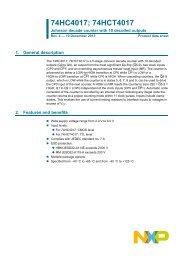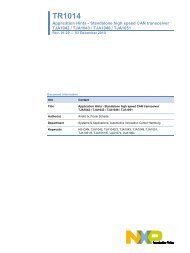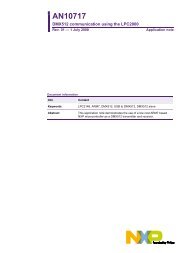AN108711 - NXP Semiconductors
AN108711 - NXP Semiconductors
AN108711 - NXP Semiconductors
Create successful ePaper yourself
Turn your PDF publications into a flip-book with our unique Google optimized e-Paper software.
Philips <strong>Semiconductors</strong><br />
3.5 Card Interface Mode<br />
Application Note<br />
Tips and Tricks for PN51x Integration<br />
The following restrictions apply, when the PN51x is used in card emulation<br />
3.5.1 Mifare Crypto<br />
• No real “UID” 12<br />
The ID can be arbitrarily configured by the host controller. Although the<br />
probability is very low (1/2 24 ), it could occur that two targets choose the same ID.<br />
The Initiator will not detect any collision in the anti-collision phase. Hence a new<br />
ID shall be generated after every session in order to prevent collisions over<br />
several sessions. For this purpose the random number generator was included in<br />
the PN51x design.<br />
• The first byte of the ID is fixed and has the value 08h<br />
which is according to ISO/IEC 14443-3A and prevents UID clashes with existing<br />
smart cards.<br />
• No Cascade Level 2 and 3<br />
The PN51x only supports IDs for Cascade Level 1. Some tags like Mifare® UL<br />
use a double UID (7bytes UID). A PCD which receives the first part with the<br />
cascade bits set (indicating CL2) will ask for the second part of the UID which<br />
PN51x is not able to deliver.<br />
The Mifare encryption is only implemented for reader mode. There is no way to emulate<br />
the card–side cryptography as the algorithm is not disclosed.<br />
3.6 Timings<br />
3.6.1 ISO/IEC 14443-3A<br />
The initialization phase is completely performed by the PN51x. The needed information<br />
(ID, SEL_RES…) can be configured beforehand. The selection of the card is signaled by<br />
an interrupt (if so configured). After that the host controller has to interact with the PN51x<br />
in order to follow the ISO/IEC 14443-3A protocol flow.<br />
3.6.2 T=CL (ISO/IEC 14443-4) Card (106kBit/s)<br />
Data exchange is covered by the ISO/IEC14443-4 (“Transmission Protocol”). This<br />
protocol is entered beforehand by performing the anti-collision procedure according to<br />
the ISO/IEC 14443-3A protocol. By specifying the appropriate bit in SAK (SEL_RES) the<br />
PCD is informed that the PICC is capable handling the ISO/IEC 14443-4 protocol. This<br />
protocol is then entered by the command RATS. The PICC has to compose the ATS.<br />
This response has to be sent back within 4.8ms. The ATS is the first response, which has<br />
to be assembled (correct framing due to RATS parameters) by the PN51x’s host<br />
controller. The ATS can also specify new timeout values, which are valid for the<br />
subsequent responses. This timeout value is specified as FWT (Frame Waiting Time).<br />
(Please refer to chapter 5.2.5 in the ISO/IEC 14443-4 standard.) The only exception is<br />
that the DESELECT command has to be responded within 4.8ms even if the timeout<br />
value has specified a different value.<br />
12. ID = Identifier, UID = Unique Identifier<br />
© Koninklijke Philips Electronics N.V. 2006. All rights reserved.<br />
Application note Rev. 01.10 — 11. May 2006 19 of 37





